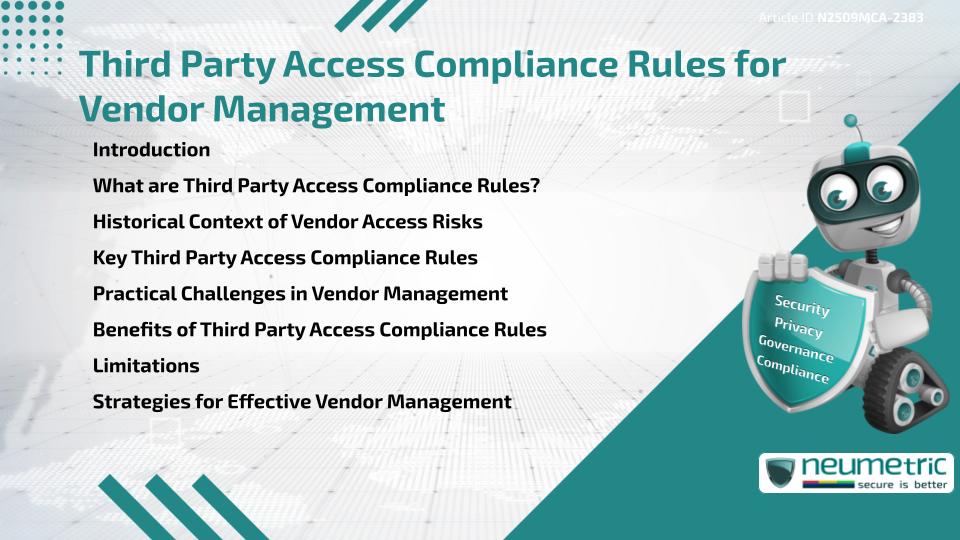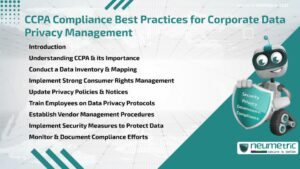Table of Contents
ToggleIntroduction
Third Party Access Compliance Rules are essential for Enterprises that rely on External Vendors, Contractors & Partners to handle Sensitive Systems or Data. Weak Vendor Oversight can expose organisations to Breaches, Regulatory Penalties & Reputational Harm. By establishing clear Compliance Rules, Enterprises ensure Vendors meet the same Standards of Security & Governance as Internal Teams.
What are Third Party Access Compliance Rules?
Third Party Access Compliance Rules are Policies & Requirements that Regulate how External Vendors interact with Enterprise Systems & Data. These Rules typically cover Authentication, Access limits, Monitoring & Contractual obligations. They align Vendor Practices with recognised Frameworks such as ISO 27001, NIST & GDPR, ensuring Accountability & Consistency in Vendor Management.
Historical Context of Vendor Access Risks
Historically, Enterprises often granted Vendors broad & uncontrolled Access to Networks. This approach increased Risks of Insider Threats & Supply Chain Breaches. High-profile Security Incidents over the past two decades highlighted the dangers of weak Vendor Oversight. In response, Regulators & Industry bodies introduced stricter requirements, making Third Party Access Compliance Rules a Standard expectation in Modern Governance.
Key Third Party Access Compliance Rules
Effective Vendor Management Frameworks include:
- Access Restrictions: Vendors should be given only the minimum Access required.
- Authentication Controls: Multi-factor Authentication must be mandatory for Third Parties.
- Monitoring & Logging: Continuous Monitoring of Vendor activities to detect Anomalies.
- Contractual Safeguards: Data Processing Agreements [DPAs] with Compliance Clauses.
- Breach Notification: Vendors must report Incidents promptly & transparently.
- Regular Reviews: Periodic Audits to verify ongoing Compliance with Enterprise Policies.
Practical Challenges in Vendor Management
Applying Third Party Access Compliance Rules can be difficult. Large Enterprises often work with hundreds of Vendors, making Oversight Resource intensive. Vendors operating across jurisdictions may follow different Regulatory Standards, complicating alignment. Smaller businesses may lack Tools for Automated monitoring, relying heavily on Manual Oversight.
Benefits of Third Party Access Compliance Rules
Despite challenges, Compliance Rules provide clear benefits:
- Stronger protection against Supply Chain Attacks & Insider Threats
- Reduced Liability through documented Governance & Contracts
- Improved Trust with Regulators, Customers & Partners
- Streamlined Procurement through Standardised Compliance Frameworks
- Better visibility into Vendor Activities & Risks
Limitations
Some critics argue that strict Rules may slow down Vendor onboarding or strain Partnerships. Vendors may resist detailed monitoring requirements, viewing them as Intrusive. Compliance Frameworks also require ongoing Investment, which may be burdensome for Smaller organisations.
Strategies for Effective Vendor Management
To implement Third Party Access Compliance Rules effectively, Enterprises should:
- Conduct Vendor Risk Assessments before Onboarding
- Standardise Contracts with clear Compliance Obligations
- Use Automated Identity & Access Management Tools for Oversight
- Provide Vendor-specific Training on Security Policies
- Align Practices with Global Governance Resources from OECD, World Bank & ENISA
Takeaways
Third Party Access Compliance Rules are Central to protecting Enterprise Systems & Data in Vendor relationships. By embedding these Rules into Contracts, monitoring Practices & Governance Frameworks, organisations can reduce Risks, improve trust & ensure effective Vendor Management.
FAQ
What are Third Party Access Compliance Rules?
They are Policies Regulating how Vendors Access Enterprise Systems & Data.
Why are they Important?
They protect against Supply Chain Threats, ensure Accountability & Align with Regulations.
What challenges do Enterprises face?
Challenges include managing large Vendor Ecosystems, Cross-border Compliance & Limited Resources.
What are Key Compliance Rules?
Restricted Access, Authentication, monitoring, Contracts, Breach Notification & Audits.
Do these Rules slow down Vendor Onboarding?
They may add steps, but they ultimately strengthen Security & Trust.
References
- ISO 27001 – Information Security
- NIST CyberSecurity Framework
- OECD Privacy Guidelines
- World Bank Digital Development
- ENISA – European Union Agency for CyberSecurity
Need help for Security, Privacy, Governance & VAPT?
Neumetric provides organisations the necessary help to achieve their CyberSecurity, Compliance, Governance, Privacy, Certifications & Pentesting needs.
Organisations & Businesses, specifically those which provide SaaS & AI Solutions in the Fintech, BFSI & other Regulated sectors, usually need a CyberSecurity Partner for meeting & maintaining the ongoing Security & Privacy needs & requirements of their Enterprise Clients & Privacy conscious Customers.
SOC 2, ISO 27001, ISO 42001, NIST, HIPAA, HECVAT, EU GDPR are some of the Frameworks that are served by Fusion – a SaaS, multimodular, multitenant, centralised, Automated, CyberSecurity & Compliance Management System.
Neumetric also provides Expert Services for technical Security which covers VAPT for Web Applications, APIs, iOS & Android Mobile Apps, Security Testing for AWS & other Cloud Environments & Cloud Infrastructure & other similar scopes.
Reach out to us by Email or filling out the Contact Form…





